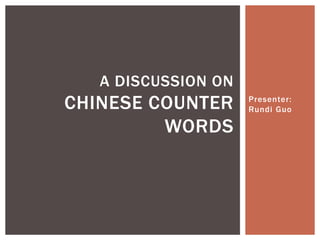
A discussion on Chinese counter words
- 1. Presenter: Rundi Guo A DISCUSSION ON CHINESE COUNTER WORDS
- 2. What are counter words? What are the subcategories of counter words? *Debates on the semantic redundancy of counter words (esp. on classifiers). limitations Purposes and significance RESEARCH QUESTIONS
- 3. 量词/数量词 Quantity words 分类词 Classifiers 单位词 Unit words 辅名词/助名词 auxiliary nouns / noun-helper words 计标 counting markers 陪伴词 accompanying words Etc… COUNTER WORDS • They are “an instance of the use of a linguistic device for the purpose of categorization.” (Zhang, 2007) • They reflect natural human categorization.. (Tai, 1994)
- 4. “A classifier categorizes a class of nouns by picking out some salient perceptual properties, either physically or functionally based, which are permanently associated with entities named by the class of nouns; A measure word does not categorize but denotes the quantity of the entity named by a noun.” (Tai & Wang, 1990, cited by Tai, 1994) The count-noun classifiers are usually used for noun entities that can occur naturally in discrete, countable units while mass-noun classifiers can be used both to quantify those nouns that do not naturally occur in discrete units and as measuring units for concrete nouns (Cheng & Sybesma, 1998; Chien, Lust, & Chiang, 2003; Loke, 1991; Tai, 1992, 1994; Tai & Wang, 1990, cited by Zhang, 2007) CLASSIFIERS VS. MEASURE WORDS
- 5. The “assumed distinction between classifiers proper and quantifiers (measure words) is really best considered a continuum, for, while there are forms that are clearly classifiers and clearly quantifiers, there are some forms that are intermediary and not clearly one or the other.” (Becker, 1975, cited by Zhang, 2007) CLASSIFIERS & MEASURE WORDS 只、张、名、条…… 磅、吨、亩、打……碗、杯、车、身、 段
- 6. Are classifiers always for individual, discrete nouns? 双、对、副…… are they classifiers or measure words? What about 只 (in the sense of “one of a pair”)? Do measure words always “quantify”? 一团面、一批货物、一束花、一笔钱 Denotes salient features of the aggregative/collective nouns 一身泥、一地垃圾、一头白发、一脸忧伤 Emphasizes the location (salient feature) of the noun rather than its quantity 一抹朝霞、一缕阳光、一股香气 Can you use numbers other than one? *两抹朝霞? PROBLEMS AND NOTABLE POINTS
- 7. Classifier / measure words Nominal / verbal (Liu et al, 1983) Standard / non-standard measuring units (Chen, 1980) Monosyllabic / multisyllabic (Xing, 1997) Semantic features that are picked out or assigned (Tai, 1994) How can they be combined? WAYS OF SUBCATEGORIZING COUNTER WORDS
- 8. Nominal classifiers 一颗苹果、一条鱼,etc. Verbal classifiers 去一趟、切一刀、踹一脚, etc. Nominal measure words 一斤肉、一碗汤,etc. Verbal measure words 跑一圈、玩一天,etc. SUBCATEGORIES OF COUNTER WORDS
- 9. Nominal Classifiers Individual classifiers Collective classifiers Measure words Unitary measure words (度量 衡) Container measure words Quantifiable Non-quantifiable (metaphorical) Aggregative measure words Partitive measure words *Non-specific measure words 一点、一些 SUBCATEGORIES OF COUNTER WORDS -- HANDOUT Verbal Classifiers (indicate how many times) 次、下、趟、回, etc. Borrowing Tools Body parts Nominal components of verbs (睡一觉) Measure words Duration Distance covered
- 10. THE NOMINAL CLASSIFIER / MEASURE WORD CONTINUUM Individual classifiers Collective classifier s Unitary measur e words Quantifiable Container measure words Non- Quantifiable Container measure words Aggregation measure words Partitive measure words
- 11. 块 一块手表 一块布 一块蛋糕 一块田地 把 一把刀 一把花生 拉了一把 口 一口饭 一口金牙、一口酒味、一口京腔 一口井 一口人 咬一口 CROSS-CATEGORY COUNTER WORDS
- 13. Numeral classifiers (nominal) add no meaning to the noun other than providing redundant information. They ‘‘are shown to be redundant when translation into a non-numeral classifier language like English is carried out.’’ (Adams, 1986; Greenberg, 1974, p. 84, cited by Zhang, 2007) E.g. 一根棍子 (a stick-shaped stick) DO CLASSIFIERS PRODUCE SEMANTIC REDUNDANCY?
- 14. “Chinese numeral classifiers (nominal) often do more than simply playing a quantifying role by providing a unit or measurement for the noun, as they also serve the qualifying function of adding special meanings to the noun… The choice of a particular classifier can help set some perimeters or a boundary to the same noun entity.” (Hu, 1993; Tai & Wang, 1990, cited by Zhang, 2007). Reduce ambiguity produced by the great number of homonyms and polysemy in words Help express side meanings more efficiently Generate stylistic effects in everyday speech and literature Metaphorical effects of counter words SIGNIFICANCE OF COUNTER WORDS
- 15. Distinguishing homonyms/different meanings of one word Chinese has a much smaller inventory of words, so the added counter words can limit possible ways of comprehension of the noun by itself, and thus reduce ambiguity 饭:一顿饭、一碗饭、一粒饭 (a meal / a bowl of food / a grain of rice) 楼:一幢楼、一层楼 (a building / a floor of a building ) 课:一节课、一门课 (a class / a course) 虫:一只虫、一条虫 (a bug / a worm) 线:一条线、一根线 (a line / a thread) SIGNIFICANCE OF COUNTER WORDS
- 16. Expressing side-meanings more effectively with the added semantic connotations 一轮月亮、一弯月亮 (a full moon / a crescent moon) 一部电影、一场电影 (a work of a movie/ a show of a movie) 一根蜡烛、一支蜡烛 (a regular candle / a somewhat fancier candle) 一个老师、一位老师 (a teacher / a respected teacher) SIGNIFICANCE OF COUNTER WORDS
- 17. Non-quantifiable container measure words 一身泥=满身泥。 一车垃圾 vs. 两车垃圾 Aggregative measure words 一群人 can mean “a lot of people”. ( 两群人 can only be “two groups of people”.) 一堆垃圾 can be “a lot of garbage”. (两堆垃圾 can only be “two piles of garbage”.) 一堆作业,*两堆作业 the metaphorical use of counter words are often restricted to the number “yi”. Other specific numbers will automatically cancel out the metaphorical meaning. METAPHORICAL EFFECTS
- 18. In literature “The use of classifiers can certainly make the language much more expressive, vivid, and innovative, since the choice of different classifiers can generate such a wide range of stylistic effects that rules of classification are often deliberately ignored or transgressed for special artistic and creative appeal.” (Zhang, 2007) 一叶小舟、一抹朝霞、一带远山、一掬清泉、一株白杨、一泓秋水、一缕阳 光…… Innovative uses of counter words “他竟遇到一件不可动摇的伟大的东西了,抬头看时,蓝裤腰上面有一座赤条 条的很阔的脊背,脊背上还有汗流下来。” ----鲁迅 《阿Q正传》 “嬉笑一通之后,开会了,在主席台上就坐的是几位要员和他们的几位婊子, 后面站立的是他们的几扇保镖。” ----王国有 《司令的一天》 “回头,雪地里立着一株少女,水仙花似的。“ ----邢奎 《问路》 METAPHORICAL EFFECTS
- 19. QUESTIONS?
Editor's Notes
- Explain verbal classifiers and measure words